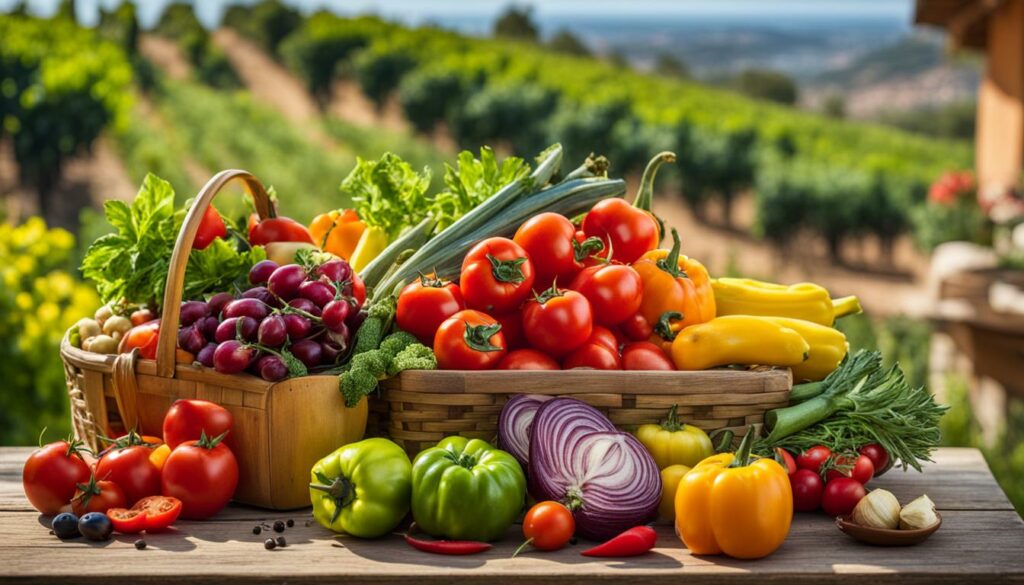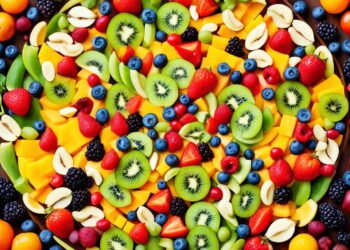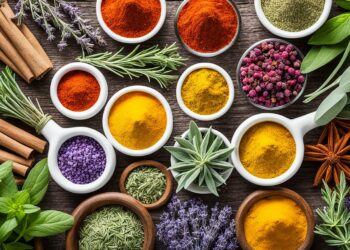Aphrodisiacs have long been associated with enhancing libido, potency, and sexual pleasure. Throughout history, certain foods have been regarded as natural aphrodisiacs, believed to ignite passion and desire. But what does the science say about the supposed powers of these aphrodisiac foods?
When it comes to the science of aphrodisiac foods, the evidence is far from conclusive. While cultural beliefs and historical associations have perpetuated the idea of certain foods as aphrodisiacs, there is limited concrete scientific proof to support their effects on sexual function.
Key Takeaways:
- The notion of aphrodisiac foods is rooted in cultural beliefs and historical associations.
- The scientific evidence behind the effects of aphrodisiac foods is questionable.
- The science of aphrodisiac foods primarily revolves around cultural and historical significance rather than concrete scientific proof.
- Further research is needed to fully understand the impact, if any, of aphrodisiac foods on sexual function.
- Desire and arousal are complex interactions influenced by various physical, psychological, and relational factors.
Historical Perspectives on Aphrodisiacs
Aphrodisiacs have a rich history entangled with notions of reproduction, fertility, and sexual function. Throughout different cultures, certain foods have been believed to possess unique properties that enhance desire and performance.
These historical aphrodisiacs were often associated with married couples and considered more of a medical substance rather than a delicacy.
Truffles, foie gras, asparagus, and even animal testicles are examples of historical aphrodisiacs that have been touted for their supposed ability to stimulate sexual desire.
However, the scientific evidence supporting these claims is lacking. While these foods may have cultural significance and historical associations with fertility, their direct impact on sexual function remains unproven.
“Throughout different cultures, certain foods have been believed to possess unique properties that enhance desire and performance.”
Although historical perspectives have attributed aphrodisiac qualities to specific foods, it is important to approach these claims with a critical mindset.
While some foods may have indirect effects on sexual function by promoting overall well-being or contributing to aspects such as blood flow or hormonal balance, their aphrodisiac qualities may be more myth than reality.
Foods that Boost Circulation and Sexual Function
Certain foods play a role in improving blood flow to the genitals, which can enhance sexual function. By relaxing blood vessels and increasing nitric oxide production, these foods promote better circulation.
Additionally, omega 3 fatty acids found in specific foods contribute to improved blood flow and overall cardiovascular health. Incorporating these foods into your diet may have a positive impact on blood flow and potentially enhance sexual function.
Foods for Blood Flow
Here are some foods that are known to support blood flow:
- Pumpkins: Rich in L-arginine, pumpkins can stimulate nitric oxide production and promote vasodilation. This increased blood flow can benefit sexual function.
- Walnuts: Packed with omega 3 fatty acids and L-arginine, walnuts support cardiovascular health and blood flow.
- Beef: A good source of L-arginine, lean cuts of beef can help improve blood flow and overall circulation.
Foods for Sexual Function
In addition to promoting blood flow, certain foods are believed to have direct effects on sexual function due to their nutritional composition. Here are some examples:
- Salmon: Rich in omega 3 fatty acids, salmon supports cardiovascular health and may indirectly improve sexual function.
- Avocado: Another source of omega 3 fatty acids, avocado contributes to healthy blood flow and may have a positive impact on sexual function.
It’s important to note that while these foods can benefit individuals with compromised blood flow, their impact on sexual function may be limited for those with already healthy circulation.

| Foods for Blood Flow | Foods for Sexual Function |
|---|---|
| Pumpkins | Salmon |
| Walnuts | Avocado |
| Beef |
The Role of Chocolate and Desire
Chocolate has long been associated with increased sexual desire. The rich, velvety texture, combined with its indulgent taste, has made it a popular choice for romantic occasions and intimate settings. But does chocolate really have an aphrodisiac effect?
Several studies have explored the relationship between cocoa, the main ingredient in chocolate, and blood flow. One study published in the Journal of Nutrition found that cocoa consumption can enhance peripheral blood flow, which may indirectly contribute to heightened sexual pleasure and desire.
However, it is important to note that this improvement in blood flow is not specific to sexual function.
While cocoa does contain phenylethylamine, a compound that can promote feelings of euphoria and well-being, there is no scientific evidence to support the notion that it directly boosts sexual desire. The impact of chocolate on desire is inconclusive and may vary from person to person.
Here is a table summarizing the key findings:
| Research | Verdict |
|---|---|
| Studies on cocoa and blood flow | No direct evidence of an aphrodisiac effect |
| Chocolate’s impact on desire | Inconclusive and subjective |
Chocolate’s Impact on Mood and Sensations
While chocolate may not be a surefire aphrodisiac, it can still contribute to a sensual experience. The rich flavor and smooth texture can evoke pleasure and enhance the overall mood. Its consumption releases feel-good hormones, such as serotonin and endorphins, which can create a sense of relaxation and happiness.
It’s important to remember that desire is a complex interplay of physical, psychological, and relational factors. The enjoyment of chocolate and the associated sensory experience may contribute to a heightened sense of pleasure and desire.
Ultimately, while chocolate may not possess magical aphrodisiac powers, it can certainly set the stage for a romantic evening and enhance the overall sensory experience. The key is to embrace the sensual aspects of chocolate and savor each moment.
The Mediterranean Diet and Aphrodisiac Qualities
The Mediterranean diet is renowned for its numerous health benefits, including its positive impact on sexual function. Consisting primarily of plant-based foods, such as fruits, vegetables, whole grains, legumes, and olive oil, this diet provides essential nutrients that support nerve function, blood flow, and hormone balance—key factors for sexual health.
Studies have shown that adhering to a Mediterranean diet can lead to improved sexual function and lower levels of sexual dysfunction. The combination of nutrient-rich foods in this diet promotes overall well-being, contributing to enhanced sexual vitality and satisfaction.
While the Mediterranean diet is often associated with aphrodisiac qualities, it’s important to note that these effects may stem from various factors beyond specific foods. Lifestyle choices, such as regular physical activity, stress management, and a healthy body weight, can reinforce the positive effects of the diet on sexual function.
The genetic makeup of individuals may also play a role in how the Mediterranean diet influences sexual health. Genetic variations can impact the way our bodies process nutrients, potentially affecting the diet’s overall impact on sexual function.

Incorporating the Mediterranean diet into your lifestyle not only supports your overall health but also contributes to a fulfilling and satisfying sexual experience. Its emphasis on whole, natural foods provides a solid foundation for promoting sexual wellness, though it’s essential to approach the diet holistically, considering all aspects of physical, mental, and emotional well-being.
By adopting a Mediterranean diet, individuals can positively impact their sexual function, while enjoying a diverse range of delicious, nutrient-dense foods. However, it’s important to remember that there is no single food or diet that guarantees heightened sexual desire or performance.
Sexual wellness is influenced by a combination of factors, and a healthy diet is just one piece of the puzzle.
The Influence of Context and Belief
The perceived effects of aphrodisiacs are influenced by the placebo effect, belief, and the context in which the food is consumed. These factors play significant roles in shaping desire and arousal.
The placebo effect refers to the psychological phenomenon where an individual experiences the desired effects of a treatment or substance simply because they believe it will work.
In the case of aphrodisiacs, the belief that a certain food can increase desire can enhance an individual’s capacity for arousal. The power of the mind and expectation are crucial factors in shaping our experiences.
The context in which the food is consumed also contributes to its perceived aphrodisiac qualities. Cultural and social factors, such as romantic settings or the anticipation of a romantic encounter, can heighten the psychological impact of aphrodisiacs.
Desire is a complex interaction involving physical, psychological, and relational factors, and the context in which a food is consumed can enhance the overall experience.
The Placebo Effect and Psychological Impact
The placebo effect plays a significant role in the psychological impact of aphrodisiacs. Belief and expectation can influence desire and arousal. The context in which the food is consumed also contributes to its perceived aphrodisiac qualities.
The power of the mind and expectation are crucial factors in shaping our experiences. If an individual believes that a certain food increases desire, the placebo effect may enhance their capacity for arousal.
The Role of Belief and Context
Belief in the aphrodisiac qualities of certain foods can create a psychological impact on an individual’s desire and arousal. If an individual firmly believes that consuming a particular food will increase their sexual desire, they may experience a heightened sense of arousal, even without any direct physiological effects.
The context in which the food is consumed also contributes to its perceived aphrodisiac qualities. The social and cultural associations surrounding the food, such as romantic settings or the anticipation of a romantic encounter, can enhance the psychological impact and further stimulate desire.
Ultimately, the influence of context and belief on the perceived effects of aphrodisiacs highlights the complex nature of desire and arousal. It reinforces the role of psychological factors in shaping our experiences and emphasizes the importance of individual perceptions and expectations.
The Connection Between Food and Sexual Vitality
When it comes to enhancing sexual vitality, the overall diet plays a crucial role. While there are claims about specific foods having aphrodisiac qualities, it is essential to understand that it is the overall dietary pattern that has a significant impact.
A balanced diet that includes a variety of nutrients can support nerve function, improve blood flow, and regulate hormone levels, thereby promoting sexual function.
So, what constitutes a healthy and balanced diet for sexual vitality? Let’s take a closer look:
- Seafood: Rich in omega-3 fatty acids and zinc, seafood like salmon and oysters can improve blood circulation and support hormone production.
- Lean Meats: High-quality protein from lean meats such as chicken and turkey provides essential amino acids necessary for hormone synthesis and overall sexual health.
- Nuts: Nut varieties like almonds and walnuts are excellent sources of L-arginine, an amino acid that helps relax blood vessels, promoting better blood flow to the genital area.
- Fruits and Vegetables: Packed with antioxidants and essential vitamins, fruits and vegetables contribute to overall health and well-being. Berries, watermelon, spinach, and broccoli are particularly known for their aphrodisiac qualities.
- Whole Grains: Opting for whole grain products like quinoa and brown rice can provide a steady release of energy, helping maintain stamina and vitality.
By incorporating these foods into your diet, you can improve blood flow, increase hormone production, and elevate mood, all of which contribute to enhanced sexual vitality. However, it is crucial to note that there is no single food with a direct and potent aphrodisiac effect. Rather, it is the collective impact of a well-rounded, nutrient-dense diet that promotes overall sexual health.
A healthy diet, combined with regular exercise and a positive mindset, can help individuals experience improved sexual function and well-being. It is important to approach sexual vitality as a holistic aspect of overall wellness, focusing on lifestyle choices that support physical, mental, and emotional health.
“A balanced diet rich in nutrients can positively impact sexual function and overall well-being.”
| Food Group | Key Nutrients | Aphrodisiac Qualities |
|---|---|---|
| Seafood | Omega-3 fatty acids, zinc | Improved blood circulation, hormone support |
| Lean Meats | Protein, amino acids | Hormone synthesis, sexual health |
| Nuts | L-arginine | Better blood flow to genital area |
| Fruits and Vegetables | Antioxidants, vitamins | Overall health, aphrodisiac properties |
| Whole Grains | Fiber, energy | Sustained stamina, vitality |
The Evolutionary Perspective on Aphrodisiacs
When it comes to sexual desire, an evolutionary perspective suggests that various factors influence our cravings and preferences. Environmental cues and previous experiences play a significant role in shaping our desires and mating patterns.
Humans, being highly suggestive creatures, form strong memories associated with sexual success, which can impact future desires.
One of the driving forces behind sexual desire is the primal hunger drive. From an evolutionary standpoint, our bodies are wired to seek out and engage in sexual activity to ensure reproductive fitness. This innate need for procreation may influence our desires and the specific traits we find attractive in potential partners.
Certain foods have been historically associated with arousal and attractiveness, and this connection can be understood from an evolutionary perspective.
For example, foods that contribute to physical appearance and reproductive health might have been intuitively associated with increased desire and attractiveness. These associations may have persisted over time, shaping cultural beliefs around aphrodisiac foods.
While the evolutionary perspective sheds light on the potential influences on desire and mating patterns, it’s important to note that individual experiences, cultural influences, and psychological factors also play significant roles.
The complex interplay between biology, psychology, and society shapes our desires, making the topic of aphrodisiac foods a fascinating area of exploration.
| Factors Influencing Desire and Mating Patterns | Summary |
|---|---|
| Environmental cues | Environmental cues can trigger desire and influence mating patterns. |
| Previous experiences | Previous sexual experiences shape future desires and preferences. |
| Hunger drive | The primal need for reproduction can drive sexual desire. |
| Reproductive fitness | Desires may be influenced by traits associated with reproductive success. |
| Physical appearance | Certain foods may be intuitively associated with increased attractiveness. |
Understanding the evolutionary perspective on aphrodisiacs allows us to appreciate the intricate interplay between nature and nurture when it comes to desire. While the allure and potential effects of aphrodisiac foods may vary from person to person, exploring their historical significance and cultural symbolism adds to the richness of human experiences.
Conclusion
The myth or reality of aphrodisiac foods is a topic that has fascinated people throughout history. However, when it comes to scientific evidence, the truth is not as clear-cut as popular belief may suggest.
While certain foods have been associated with increased libido, potency, and sexual pleasure, their effects on sexual function are largely indirect and not fully supported by concrete scientific research.
Instead, the notion of aphrodisiac foods is deeply rooted in cultural beliefs, historical associations, and individual experiences. The idea that specific foods have the power to enhance sexual desire and performance lacks conclusive evidence.
It is important to recognize that the connection between food and sexual vitality is multifaceted and complex, requiring a holistic approach to sexual wellness.
Factors such as improved blood flow and hormonal balance may contribute to enhanced sexual function and overall well-being. However, the placebo effect and the context in which the food is consumed also play significant roles in the perceived aphrodisiac qualities of certain foods.
It is crucial to approach the topic with a critical mindset and not rely solely on the idea that specific foods can guarantee heightened sexual experiences.
Ultimately, the myth or reality of aphrodisiac foods remains a subject of ongoing inquiry. While some foods may indirectly impact sexual function, no single food has been scientifically proven to have a potent aphrodisiac effect.
Instead, focusing on overall sexual health, healthy lifestyle habits, and open communication in relationships can contribute to a fulfilling and satisfying sexual experience.
FAQ
Are aphrodisiac foods scientifically proven to boost libido?
The scientific evidence behind the effects of aphrodisiac foods is questionable. While certain foods may have indirect effects on sexual function, there is no conclusive evidence that any food has a potent aphrodisiac effect.
What are some historical examples of aphrodisiac foods?
Historically, truffles, foie gras, asparagus, and even animal testicles were considered aphrodisiac foods. However, the idea that these foods have a direct impact on sexual desire and performance lacks scientific evidence.
Do certain foods boost circulation and improve sexual function?
Foods rich in L-arginine, such as pumpkins, walnuts, and beef, can increase the production of nitric oxide, which enhances blood flow. Omega 3 fatty acids found in salmon and avocado also contribute to improved circulation. However, their impact on sexual function may be limited for those with healthy circulation.
Is chocolate a reliable aphrodisiac?
While chocolate has long been associated with increased sexual desire, its impact on sexual function is inconclusive. Cocoa can improve peripheral blood flow, but no evidence supports its use as a direct aphrodisiac.
Does the Mediterranean diet have aphrodisiac qualities?
The Mediterranean diet, rich in plant-based foods, has been associated with improved sexual function. However, the specific aphrodisiac qualities may be attributed to a combination of factors, such as lifestyle and genetic influences.
What role does belief and context play in the perception of aphrodisiacs?
The placebo effect and the context in which the food is consumed play significant roles in perceived aphrodisiac qualities. Belief and expectation can influence desire and arousal.
Can an overall balanced diet enhance sexual vitality?
A healthy, balanced diet that includes seafood, lean meats, nuts, fruits, vegetables, and whole grains supports nerve function, blood flow, and hormone regulation. Improved blood flow, increased hormone production, and elevated mood may contribute to enhanced sexual vitality.
What is the evolutionary perspective on aphrodisiacs?
From an evolutionary standpoint, sexual desire is influenced by various factors, including environmental cues and previous experiences. Humans are highly suggestive, and certain foods may have been historically associated with arousal and attractiveness due to their impact on physical appearance and reproductive health.
Should I rely on aphrodisiac foods for enhancing my sexual wellness?
The notion of aphrodisiac foods is rooted in cultural beliefs, historical associations, and individual experiences rather than scientific evidence. While certain foods may have indirect effects on sexual function, a holistic approach to sexual wellness is recommended.




